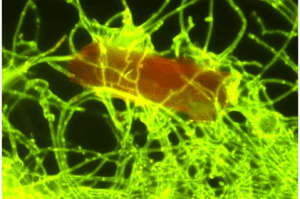TAG: GS 3: ECOLOGY AND ENVIRONMENT
THE CONTEXT: A groundbreaking study has identified the fungus Parengyodontium album as capable of degrading polyethylene (PE) plastic in marine environments.
EXPLANATION:
- This finding, published in the journal Science of the Total Environment, highlights the potential of marine fungi in mitigating plastic pollution in oceans.
- Researchers from the Royal Netherlands Institute for Sea Research (NIOZ) and their international collaborators conducted this study, emphasizing the role of UV radiation in facilitating the degradation process.
Parengyodontium album
- Parengyodontium album is a marine fungus that resides within biofilms on plastic debris in the ocean, coexisting with other marine microbes.
- The NIOZ team discovered that this fungus can degrade particles of polyethylene, which is the most prevalent type of plastic in oceanic pollution.
- The research demonstrated that P. album degrades PE at a rate of approximately 0.05% per day.
- This process primarily converts the plastic into carbon dioxide (CO2), with minimal assimilation of the plastic’s carbon into the fungal biomass.
- The CO2 release by the fungus is comparable to the amount exhaled by humans and does not pose additional environmental concerns.


Importance of UV Radiation
- The degradation ability of album is contingent upon prior exposure of the plastic to UV radiation from sunlight.
- UV light mechanically breaks down the plastic, facilitating subsequent biological degradation by the fungus.
- This implies that P. album can only act on plastic that has floated near the ocean’s surface, where it can be exposed to sunlight.
Broader Implications for Marine Fungi
- The discovery of P. album adds to the small list of known marine fungi capable of degrading plastic—currently, only four species are identified.
- However, researchers believe that many more such fungi exist, particularly in the deeper ocean layers.
- The ability of marine fungi to decompose complex carbon-based materials suggests that other species may also contribute to plastic degradation.
- Further research is needed to explore the dynamics of plastic degradation in deeper ocean layers.
- The study anticipates discovering additional fungi with similar capabilities, which could be crucial for addressing plastic pollution at various ocean depths.
The Urgency of Addressing Plastic Pollution
- Humanity produces over 400 billion kilograms of plastic annually, with projections indicating a potential tripling by 2060.
- A significant portion of this plastic ends up in the ocean, polluting surface waters, sinking to greater depths, and accumulating on the seafloor.
- Large amounts of plastic waste are trapped in subtropical gyres—vast, slow-moving circular ocean currents.
- For instance, the North Pacific Subtropical Gyre alone contains around 80 million kilograms of floating plastic.
- This phenomenon underscores the pressing need for effective strategies to combat plastic pollution.
Collaborative Efforts and Future Directions
- The study involved a collaborative effort among researchers from NIOZ, Utrecht University, the Ocean Cleanup Foundation, and institutions in Paris, Copenhagen, and St. Gallen, Switzerland.
- This international cooperation highlights the global recognition of and response to the plastic pollution crisis.
Potential for Biotechnological Applications
- The findings from this research could pave the way for innovative biotechnological solutions to plastic pollution.
- Harnessing the plastic-degrading capabilities of marine fungi could become a critical component of broader environmental remediation strategies.
SOURCE: https://phys.org/news/2024-06-fungus-ocean-plastic.html
Spread the Word
